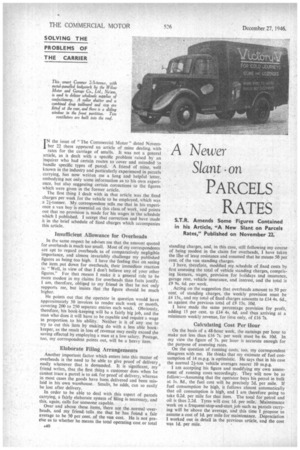A Newer Slant • on
Page 42

If you've noticed an error in this article please click here to report it so we can fix it.
PARCELS RATES
S.T.R. Amends Some Figures Contained in his Article, "A New Slant on Parcels Rates," Published on November 22.
IN the issue of "The Commercial Motor" dated Novem ber 22 there appeared an article of mine dealing with rates for the carriage of smalls. It was not a general article, as it dealt with a specific problem raised by an inquirer who had certain routes to cover and intended to handle specific types of parcel. A friend of mine, well known in the industry and particularly experienced in parcels carrying, has now written me a tong and helpful letter, embodying not only some information as to his own experience, but also suggesting certain corrections to the figures which were given in the former article.
The first thing I dealt with in that article was the fixed charges per week for the vehicle to be employed, which was a 2f-tonner. My correspondent tells mc that in his experience a van boy is essential on this class of work, and points out that no provision is made for his wages in the schedule which 1 published. I accept that correction and have made it in the brief schedule of fixed charges which accompanies this article.
Insufficient Allowance for Overheads
In the same respect he advises me that the amount quoted for overheads is much too small. Most of my correspondents are apt to regard overheads as of comparatively negligible importance, and almost invariably challenge my published figures as being too high. I have the feeling that on seeing the item put down for overheads, their immediate reaction is: "Well, in view of that I don't believe any of your other figures." For that reason I make it a general rule to be more modest in my claims for overheads than facts justify. 1 am, therefore, obliged to my friend in that he not only supports me, but insists that the figure should be much higher.
He points out that the operator in question would have approximately 50 invoices to render each week or month, covering 200 to 250 separate entries each week. Obviously, therefore, his book-keeping will be a fairly big job, and the man who does it will have to be capable and require a wage in proportion to his ability. Neither is it of any use to try to cut this item by making do with a less able bookkeeper, as the result in loss of revenue may easily exceed the saving effected by employing a man at a low salary. Postage, too, my correspondent points out, will be a heavy item.
Elaborate Filing Arrangements
Another important factor which enters into this matter of overheads is the need to be able to give proof of delivery , easily whenever that is demanded. It is significant, my friend writes, that the first thing a customer does when he cannot trace a parcel is to ask for proof of delivery, whereas in most cases the goods have been delivered and been mislaid in his own warehouse. Smalls, he adds, can so easily be lost after delivery.
In order to be able to deal with this aspect of parcels carrying, a fairly elaborate system of filing is necessary, and this, again, calls for someone capable.
Over and above these items, there are the normal overheads, and my friend tells me that he has found a fair average to be 50 per cent. of the van cost. He is not precise as to whether he means the total operating cost or total *40 standing charges, and, in this case, still following my course of being modest in the claim for overheads, I have taken the Irne of leat resistance and assumed that he means 50 per cent, of the van standing charges.
I have, therefore, modified my schedule of fixed costs by first assessing the total of vehicle standing charges, comprising licences, wages, provision for holidays and insurance, garage rent, vehicle insurance, and interest, and the total is £9 9s. 6d. per week. Acting on the suggestion that overheads amount to 50 per cent, of standing charges, the weekly provision must be £4 15s., and my total of fixed charges amounts to £14 4s. 6d., as against the previous total of £9 13s. 10d. I have made the same percentage provision for profit, adding 15 per cent. to £14 4s. 6d. and thus arriving at a minimum weekly revenue, for time only, of £16 7s.
Calculating Cost Per Hour
On the basis of a 48-hour week, the earnings per hour to make not less than £16 7s. per week must be 6s. I0d. In my view the figure of 7s. per hour is accurate enough for the purpose of assessing rates. On the question of running costs, too, my correspondent disagrees with me. He thinks that my estimate of fuel consumption of 14 m.p.g. is optimistic. He says that in his case the normal 24-ton vehicle averages nearer 10 m.p.g.
I am accepting his figure and modifying my own assessment of running costs -accordingly. They will now be as follow:—Assuming that the operator buys his petrol in bulk at Is. 8d., the fuel cost will be precisely 2d. per mile. If fuel consumption be high, it follows almost automatically that oil consumption is high, and I am therefore going to take 0,2d, per mile for that item. The total for petrol and oil is thus 2.2d. Tyres will cost Id. per mile. Maintenance work on a frequent-stop-and-start. job such as parcels carrying will be above the average, and this time I propose to assume a cost of Id. per mile for maintenance. Depreciation I worked out in detail in the previous article, and the cost was Id. per mile.




































































